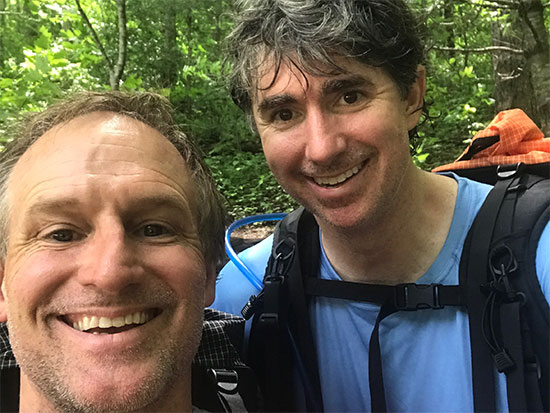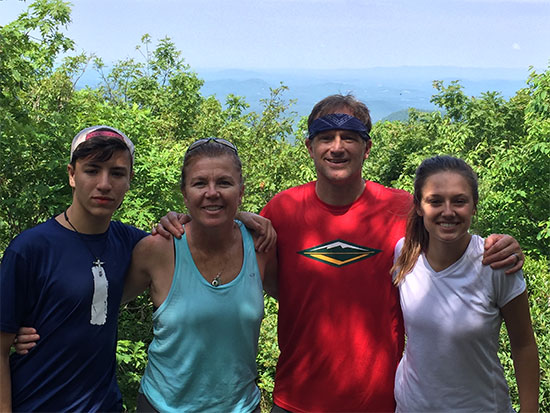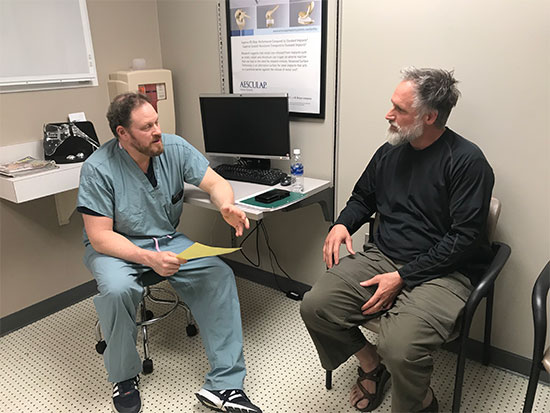 JC Cunningham, left, and Michael Flanagan, M.D., on the trail.Backpacking is hard enough without a softball-sized tumor in your leg. Not that it stopped JC Cunningham from tackling a section of the Appalachian Trail near Wesser, North Carolina, last Memorial Day. His hiking partner — a physician — had other thoughts.
JC Cunningham, left, and Michael Flanagan, M.D., on the trail.Backpacking is hard enough without a softball-sized tumor in your leg. Not that it stopped JC Cunningham from tackling a section of the Appalachian Trail near Wesser, North Carolina, last Memorial Day. His hiking partner — a physician — had other thoughts.
“My left leg had swelled up a good bit,” Cunningham recalled. “My friend said my left leg looked like Earl Campbell’s, while the right one looked like a stick figure.”
About three months earlier, in March of 2017, Dothan native Cunningham and his teen-age son were removing a hard top from a Jeep. The son started to lose his grip and Cunningham took the weight on his left leg.
“We were about to drop it, and it’s too expensive for that, so I braced it on my leg,” Cunningham said. “I developed a large bruise that just kept getting worse. Of course, as many people tend to do, I ignored it.”
Until his hiking buddy, Michael Flanagan, M.D., got a look at it. Flanagan sent Cunningham straight to an orthopedic surgeon in Dothan, Patrick Guin, M.D. Guin suspected a tumor called a spindle cell sarcoma. A big one.
Guin sent Cunningham to the man he calls “The Sarcoma King,” Herrick Siegel, M.D., an orthopedic surgeon at the University of Alabama at Birminghamwho has specialized in treating soft-tissue and bone cancer for more than 15 years. A biopsy confirmed Guin’s suspicions of a sarcoma.
“Spindle cell sarcoma is a soft-tissue tumor that can start in the bone, often in the arms, legs or pelvis,” said Siegel, a professor in the Department of Orthopedic Surgery in the School of Medicine. “Soft-tissue sarcomas are rare in adults, accounting for less than 1 percent of all new cases of cancer.”
Sarcomas can be found almost anywhere in the body. According to the National Cancer Institute, about 50 percent of soft-tissue sarcoma cases occur in the arms and legs, 40 percent occur in the back and chest, and 10 percent occur in the head and neck. The American Cancer Society reports that about 13,000 new cases of soft-tissue sarcoma will be diagnosed in 2018.
 The Cunningham family, son Tristin, Sherie, JC and daughter Dara.Sarcomas can be quite serious. They can cause loss of a leg or arm, and have about a 30 percent mortality rate in advanced stages.
The Cunningham family, son Tristin, Sherie, JC and daughter Dara.Sarcomas can be quite serious. They can cause loss of a leg or arm, and have about a 30 percent mortality rate in advanced stages.
Guin had trained at UAB under Siegel, and knew UAB represented Cunningham’s best chance for a good outcome.
“As in most cancers, the key to successful treatment of spindle cell sarcoma is to begin therapy as soon as possible at a center that has experience in the condition,” Siegel said. “UAB is a sarcoma center and is the most experienced and comprehensive hospital in Alabama. The critical specialties, including orthopedic oncologists, musculoskeletal radiology, plastic surgery, radiation oncology and medical oncology, can all be found at UAB.”
Siegel says the cause of spindle cell sarcoma is unknown. There is a genetic predisposition; however, it is not commonly thought to be hereditary. Some rare, inherited genetic conditions are considered risk factors for soft-tissue sarcoma. They include familial adenomatous polyposis, retinoblastoma, neurofibromatosis type 1 and Li-Fraumeni syndrome.
Cunningham admits that he is a typical male and tried to fight through the pain and swelling.
“I’m a hairdresser and on my feet all day,” he said. “The pain was bad, but I thought I could tough it out. And I didn’t want to miss the backpacking trip.”
Although he delayed, he got to UAB and Siegel in time. CT imaging determined the tumor had not spread to other parts of Cunningham’s body, and he underwent five weeks of radiation to shrink the mass. Siegel then removed the soft-ball-size tumor from where it pressed against Cunningham’s femur in an operation Oct. 11.
“We had to remove a large part of the quadriceps femoris muscle to get all of the tumor,” Siegel said. “We monitor his progress every three months with magnetic resonance imaging and CT.”
Cunningham didn’t hesitate to begin recovery. He was walking in his hospital room the next day and was so excited by his progress that he sent videos of himself walking around his room to Siegel to prove it. He was raking leaves one week out from surgery and back at work in just over two weeks. Overall, he did six weeks of formal physical therapy.
 UAB orthpedia surgeon Herrick Siegel, MD, and Cunningham during a recent clinic visit.“I’d never heard of a sarcoma before, and as my physician in Dothan described it to me, it became clear that I needed to go to the place that had the most experience in dealing with this type of cancer, and that meant UAB,” Cunningham said.
UAB orthpedia surgeon Herrick Siegel, MD, and Cunningham during a recent clinic visit.“I’d never heard of a sarcoma before, and as my physician in Dothan described it to me, it became clear that I needed to go to the place that had the most experience in dealing with this type of cancer, and that meant UAB,” Cunningham said.
“His prognosis is excellent, with no sign of any remaining cancer,” Siegel said. “His positive outcome is centered on his good physical condition and the fact that we were able to remove the entire tumor before it had a chance to spread.”
Cunningham says he relied on his friends to help him navigate the often confusing and scary diagnosis of cancer.
“My friend Mike is a medical professional, and he took on the role of cancer navigator for me,” Cunningham said. “He helped sort through the confusion, the uncertainty and the questions. I really like the navigator concept.”
He says he’s back to doing most of the activities that he loves — hiking, hunting and playing with his kids. A Memorial Day backpacking trip is once again on the schedule.
“I’m thankful to have a leg and be alive,” Cunningham said. “I feel blessed even with all things I am dealing with. The end goal is to push back and return to a normal life, to where I was before.”